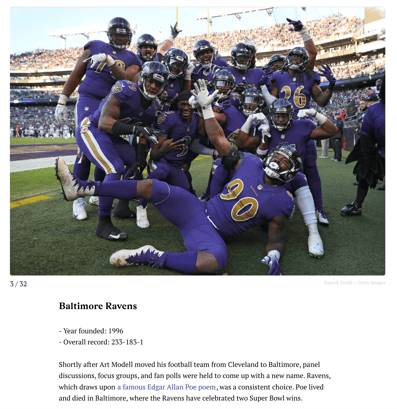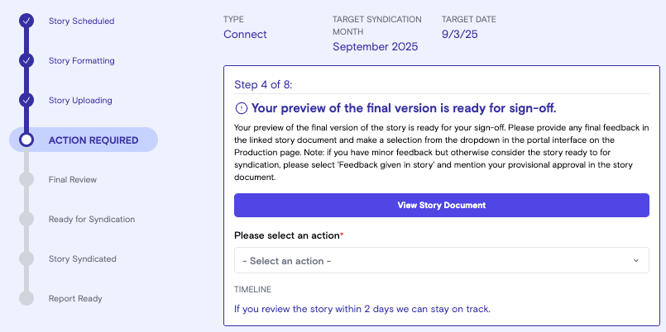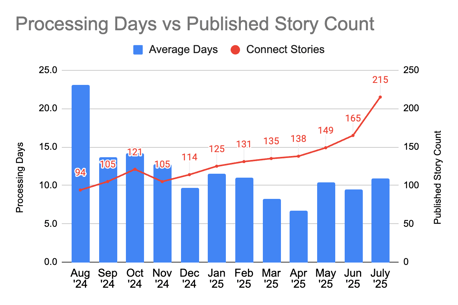At Stacker, we always aim to stay ahead of where the publishing industry is going — and where our partners need us now. Whether it’s spotting trending stories or rethinking the mechanics of how publishing happens behind the scenes, we’re committed to continuous improvement.
Recently, we put that philosophy into practice with a large-scale overhaul of our editorial and technical systems. The upgrade dramatically accelerated content delivery and expanded publishing formats — without compromising quality.
Now that we’re on the other side of this transformation, we wanted to share a behind-the-scenes look at how the platform and customer experience have been reimagined.
Problem: Strong Stories Stuck in a Lagging Pipeline
When Stacker launched eight years ago, our stories were 100% slideshow based to match the content strategy of MSN, our first distribution partner. Slideshows drove significant traffic and kept users clicking and onsite longer.

A view of our original, slideshow style stories from launch 8 years ago.
But as publishers shifted toward single-page, article-driven formats, our slideshow-centric system became a bottleneck. For years, we adapted client blogs into technically elaborate, visually dynamic slideshows because the system required it — creating slides, sourcing additional images, crafting subheads, and shepherding each step through approvals.
Only to watch some publishers re-format the content back into single-page articles.
Even though much of Stacker’s newswire features data-rich, evergreen stories, our legacy setup slowed down our publishing pipeline. It also added unnecessary labor on both sides and made it harder to deliver more timely content, especially for breaking news or urgent events like hurricanes or inflation reports.
We needed a way to eliminate wasted work, speed up time-to-publish, and still preserve the integrity of our storytelling — even as a bootstrapped company.
Solution: Overhauling the CMS & Streamlining Our Editorial Process
Solving the problem meant more than a few tweaks. Our approach to overcoming these challenges to story production required a commitment to a holistic redesign: mapping end-to-end editorial workflows, modernizing client collaboration, automating repetitive tasks, and refitting our Content Management System, or CMS, to support flexible, multi-format publishing.
The transformation wasn’t always glamorous — but it gave us the opportunity to re-engineer every step of how stories move from ideation to syndication.
Simplifying the Editorial Process
We improved our side of the house first by starting with our internal team's workload management process. Updating our task management system gave editors clearer visibility into story queues and timelines.
Then, we reduced friction in our story workflow with clients, by layering in process improvements for internal teams, such as editorial and account management, and clients alike.

View of the upgraded client portal that is optimized to improve responsiveness and efficiencies
Client Communications
We reworked the top and tail of our process to cut the time to publish by more than 2x:
- Submission: Upgraded story submission forms to request more critical information upfront, such as story images, data visualizations and bylines to reduce downstream delays.
- Approvals: Final story approvals before syndication were moved into the client portal, rather than via their Stacker account manager. This change alone halved the time spent in the final approval stages before distribution.
Editorial Automation
The Stacker editorial team works on many stories simultaneously, and it's easy to lose time by creating new documents for new rounds of edits or searching for the right version.
We sped up the process for editors and made digital drafts easier to find with automation to:
- Create templated documents as a starting place for formatting client-submitted stories
- Update story statuses based on inputs from clients
- Upload fully approved documents to our CMS in preparation for syndication
- Sync data from our internal task management system to our CMS to cut out manual metadata entry
- Write story meta descriptions to improve story clickthrough rates
These updates reduced lift for editors and tightened turnaround times, making it easier to handle larger volumes of stories to publish.

Improvements helped expedite our editorial and client review processing times to get more customer stories published and more eyes on their content.
Refitting the CMS & Rebuilding Publisher Feeds
The last link in our chain of improvements was one of the most technically demanding: rebuilding the CMS and all publisher feeds to shift from slideshow-first publishing to articles as the default format.
Slideshows now make up less than 5% of stories distributed on Stacker Connect, excluding MSN-only content. But supporting this shift required reconstructing the feeds powering syndication to more than 4,000 unique publisher domains.
It was a massive undertaking. To rebuild, the Stacker developer team redesigned, tested, and migrated feeds that supported a network of publishers that covered more than 4000 unique domains.
That meant:
- Engineering custom feed rebuilds for publishers with bespoke requirements.
- Conducting testing cycles with each partner prior to migration.
- Coordinating closely with publisher developer teams to avoid downtime or broken feeds during live story windows.
In short — it was like rewiring a jet while keeping it in flight.
🙌 The result: seamless, article-native integration across partner sites, along with faster story delivery on the newswire helping brands reach more eyes and publishers get more content efficiently and at scale.
Miriam Daub is Senior Director of Product & Operations at Stacker, where she helps bridge the gap between bold ideas and the systems that make them possible. With a background that spans engineering, finance, and media strategy, she’s led everything from CRM implementations at Voya Investment Management to revenue strategy at Twitter. When she’s not fine-tuning Stacker’s product roadmap, you can usually find Miriam exploring the outdoors near her home in Boise, perfecting her travel itineraries, or swapping book recommendations with friends.